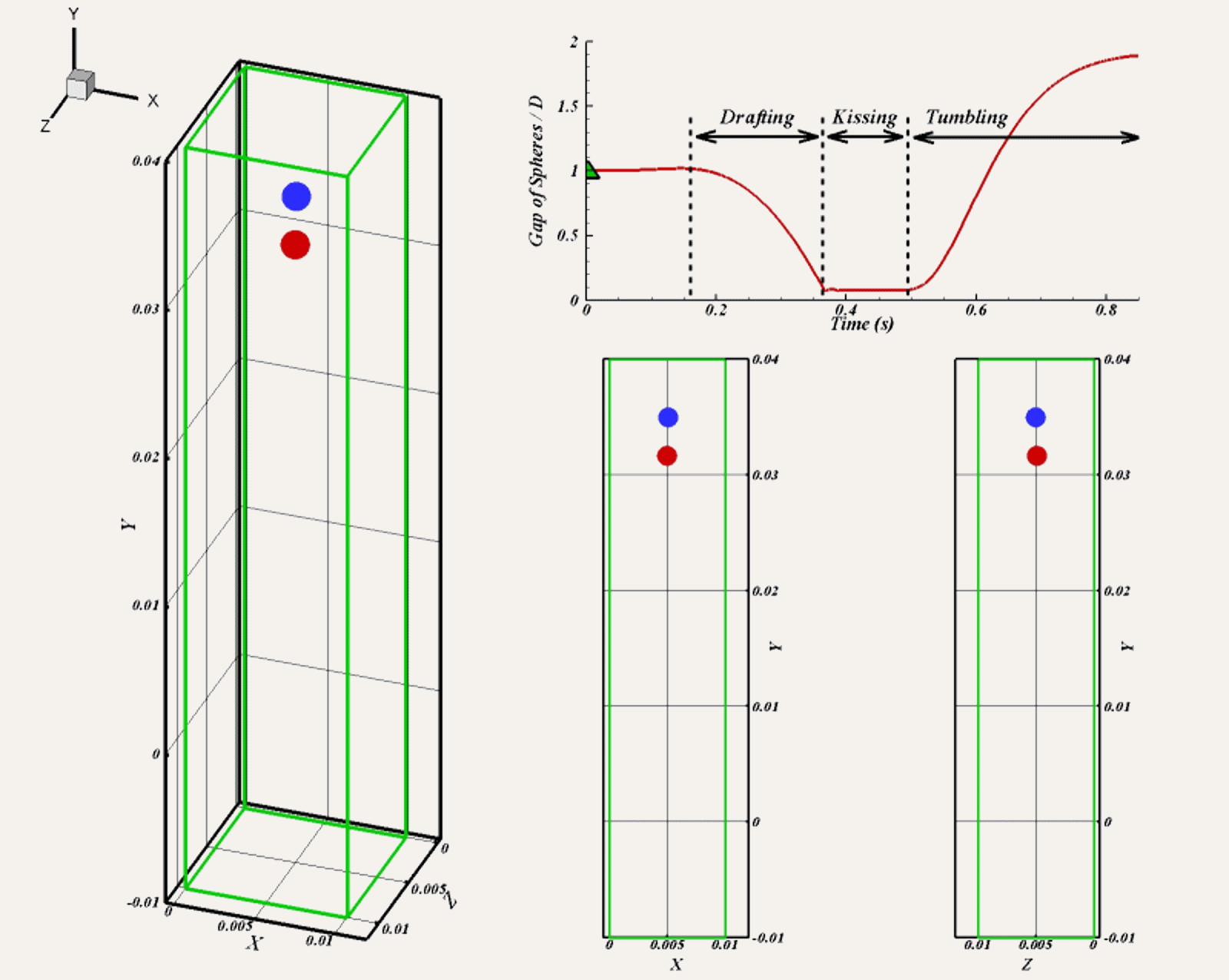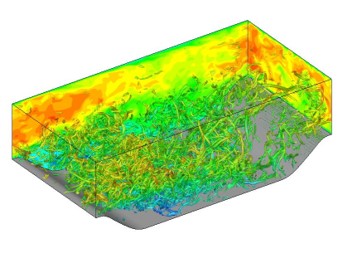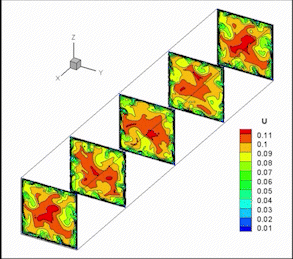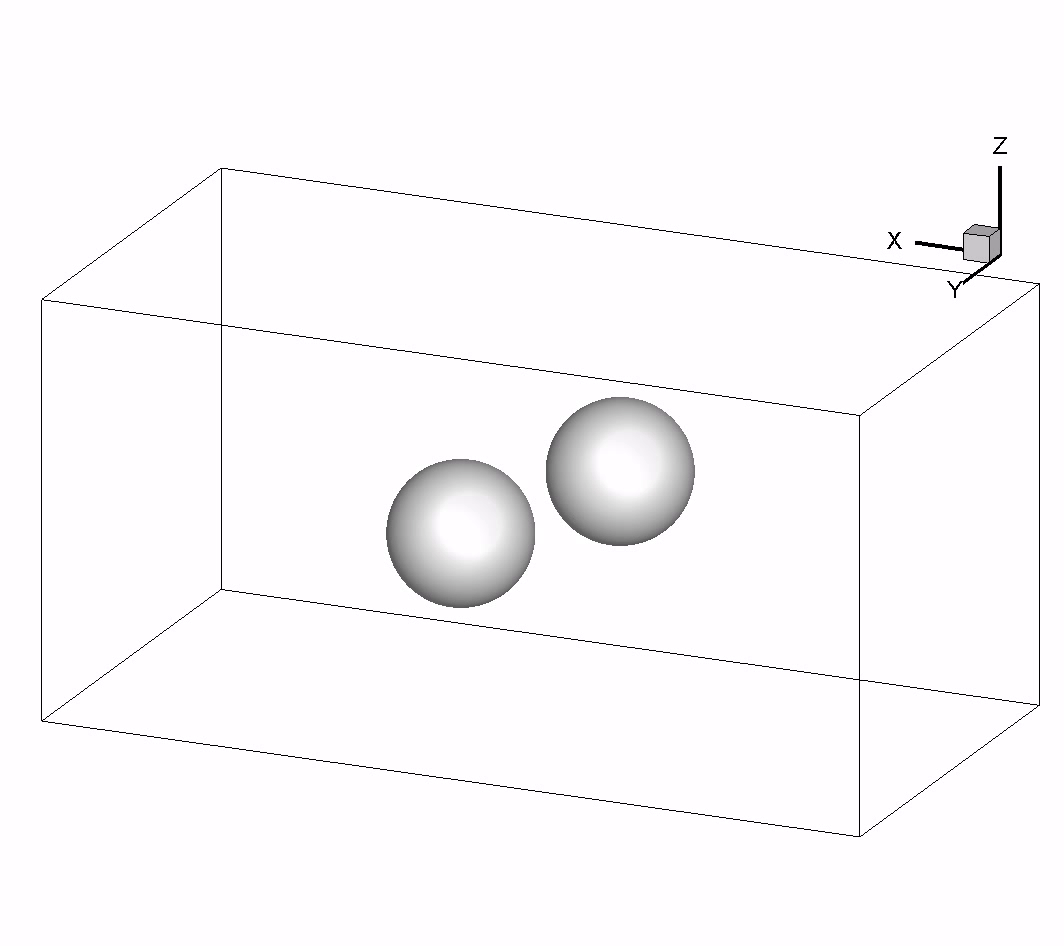Research
Computational Fluid Dynamics Lab Research
Current research in Computational Fluid Dynamics lab involve multiple numerical approaches to solving different physical problems, which include Navier-Stokes equation and Lattice Boltzmann method. The research topics are in the followings.
 |
 |
 |
 |
Su, S. W., Lai, M. C. and Lin, C. A., 2007, ''An immersed boundary technique for simulating complex flows with rigid boundary,'' Computers and Fluids Vol. 36, No. 2, pp. 313-324.
Liao, C. C., Chang, Y. W., Lin, C. A. and McDonough, J. M., 2010, "Simulating flows with moving rigid boundary using immersed boundary method," Computers and Fluids, Vol. 39 No. 1, pp. 152-167.
Liao, C. C. and Lin, C. A., 2012, Simulations of natural and forced convection flows with moving embedded object using immersed boundary method, Computer Methods in Applied Mechanics and Engineering, Vol. 213, pp. 58-70.
Liao, C. C. and Lin, C. A., 2015, Influence of Prandtl number on the instability of natural convection flows within a square enclosure containing an embedded heated cylinder at moderate Rayleigh number, Physics of Fluids, Vol. 27, 013603.
Liao, C. C., Hsiao, W. W., Lin, Y. T. and Lin, C. A., 2015, Simulations of two sedimenting-interacting spheres with different sizes and initial configurations using immersed boundary method, Computational Mechanics, Vol. 55, pp. 1191-1200.
 |
 |
Liu, C. H., Lin, K. H., Mai, H. C. and Lin, C. A., 2010, "Thermal boundary conditions for thermal Lattice Boltzmann simulations," Computers and Mathematics with applications, Vol. 59, pp. 2178-2193.
Shih, C. H., Wu, C. L., Chang, L. C. and Lin, C. A., 2011, Lattice Boltzmann simulations of incompressible liquid-gas system on partial wetting surface, Phil. Trans. R. Soc. A., Vol. 369, pp. 2510-2518.
Huang, T. C., Chang, C. Y. and Lin, C. A., 2018, Simulation of droplet dynamic with high density ratio two-phase lattice Boltzmann model on Multi-GPU cluster, Computers and Fluids, Vol. 173, pp. 80-87.
Lin, W.J., Li, M.J., Su, C.W., Huang, X.Y., Lin, C.A., 2020, Direct numerical simulations of turbulent periodic-hill flows with mass-conserving lattice Boltzmann method, Physics of Fluids, Vol. 32, 115122.
Chang, H.W., Garg, A. and Lin, C.A., 2021, Analytic solutions of the variable force effect in lattice Boltzmann methods for Poiseuille flows, Physics of Fluids, Vol. 33, 083610.
 |
Hong, P. Y., Huang, L. M., Lin, L. S. and Lin, C. A., 2015, Scalable multi-relaxation-time lattice Boltzmann simulations on multi-GPU cluster, Computers and Fluids, Vol. 110, pp. 1-8.
Hong, P. Y., Huang, L. M., Chang, C. Y., and Lin, C. A., 2017, Lattice Boltzmann Simulations of Cavity Flows on Graphic Processing Unit with Memory Management. Journal of Mechanics, Vo. 33, pp. 863-871.
Lee, Y. H., Huang, L. M., Zou, Y. S., Huang, S. C. and Lin, C. A., 2018, Simulations of turbulent duct flow with lattice Boltzmann method on GPU cluster, Computers and Fluids, Vol. 168, pp. 14-20.
Wu, C.M., Zhou, Y.S., Lin, C. A., 2020, Direct numerical simulations of turbulent channel flows with mesh-refinement lattice Boltzmann methods on GPU cluster, Computers and Fluids, Vol. 210, 104647.
Shi, X., Agrawal, T. Lin, C. A., Hwang, F.N., Chiu, T.H., 2020, A parallel nonlinear multigrid solver for unsteady incompressible flow simulation on multi-GPU cluster, Journal of Computational Physics, Vol. 414, 109447.
 |
 |
Lin, C. A. and Lu, C. M., 1994, Modelling Three-Dimensional Gas-Turbine-Combustor-Model Flow using Second-Moment Closure, AIAA Journal, Vol. 32 no 7, pp. 1416-1422.
Hwang, C. B. and Lin, C. A., 1998, An improved Low-Reynolds-Number k-e model based on Direct Numerical Simulation Data, AIAA J., Vol. 36, No. 1, pp. 38-43.
Chen, J. C. and Lin, C. A., 1999, Computations of Strongly Swirling Flows with Second-Moment Closure, I. J. of Numerical Methods in Fluids, Vol. 30, pp. 493-508.
Hwang, C. B. and Lin, C. A., 1999, A Low-Reynolds-number Two-equation k-e_theta model to Predict Thermal Fields, I. J. of Heat and Mass Transfer, Vol. 42, pp. 3217-3230.
Hwang, C. B. and Lin, C. A., 2003, Low-Reynolds-Number k-e Modelling of Turbulent Flows with a Non-Stationary Solid Boundary, AIAA Journal, Vol. 41, No. 2, pp. 168-175.
 |
 |
 |
Lo, W. and Lin, C. A., 2006, "Mean and turbulence structure of Couette-Poisueille flows at different mean strain rates," Physics of fluids, Vol. 18, No. 6, 068103.
Hsu, S. W., Hsu, J. B., Lo, W. and Lin, C. A., 2012, Large eddy simulations of turbulent Couette-Poiseuille and Couette Flows inside a square duct, J. Fluid Mechanics, Vol. 702, pp. 89-101.
Owolabi, B. E. and Lin, C. A., 2018, Marginally turbulent Couette flow in a spanwise confined passage of square cross section, Physics of Fluids, Vol. 30, 075102.
Lin, W.J., Li, M.J., Su, C.W., Huang, X.Y., Lin, C.A., 2020, Direct numerical simulations of turbulent periodic-hill flows with mass-conserving lattice Boltzmann method, Physics of Fluids, Vol. 32, 115122.
Lin, C.Y., Owolabi, B. E. and Lin, C. A., 2022, Polymer-turbulence interactions in a complex flow and implications for the drag reduction phenomenon, Physics of Fluids, Vol. 34, 043106.
Phase separation |
Stretching separation |
Shih, C. H., Wu, C. L., Chang, L. C. and Lin, C. A., 2011, Lattice Boltzmann simulations of incompressible liquid-gas system on partial wetting surface, Phil. Trans. R. Soc. A., Vol. 369, pp. 2510-2518.
Ju, Y. T., Kuo, F. C., Lin, Y. T., Huang, T. C. and Lin, C. A., 2017, Partial wetting boundary conditions on micro-structure surface for Lattice Boltzmann method, Computers and Fluids, Vol. 142, pp. 37-44
Huang, T. C., Chang, C. Y. and Lin, C. A., 2018, Simulation of droplet dynamic with high density ratio two-phase lattice Boltzmann model on Multi-GPU cluster, Computers and Fluids, Vol. 173, pp. 80-87.
Chang, C.Y., Yang, C.W., Lin, F.T., Chiu, T.H. and Lin, C.A., 2021, Lattice Boltzmann simulations of bubble interactions on GPU cluster, Journal of the Chinese Institute of Engineers, Vol. 44, pp. 491-500.
Lin, C. H. and Lin, C. A., 1997, "Simple High Order Bounded Convection Scheme to Model Discontinuities", AIAA Journal, Vol. 35, No.3, pp. 563-565.
Kuan, K. B. and Lin, C. A., 2000, ``Adaptive QUICK-Based Scheme to Approximate Convective Transport,'' AIAA Journal, Vol. 38, No. 12, pp. 2233-2237.
Liao, C. C. and Lin, C. A., 2012, Simulations of natural and forced convection flows with moving embedded object using immersed boundary method, Computer Methods in Applied Mechanics and Engineering, Vol. 213, pp. 58-70
Chen, S. H., Ku, Y., Lin, C. A., 2019 Simulations of settling object using moving domain and immersed-boundary method, Computers and Fluids, Vol. 179, pp. 735-743.
Wu, C.M., Zhou, Y.S., Lin, C. A., 2020, Direct numerical simulations of turbulent channel flows with mesh-refinement lattice Boltzmann methods on GPU cluster, Computers and Fluids, Vol. 210, 104647.
Ching, Y. T., Lin, C. Y., Tan K. C., Lau, K. L., Yang, C. H. And Lin, C. A., 2004, "Rectangular meshes construction of the human urethra using 3D GVF snakes," Proceedings of SPIE, Medical Imaging: Physiology, Function, and Structure from Medical Images, Vol. 5369, pp. 539-549
Yang, C. H, Lin, C. A., Wang, S. J. and Lin, T. L., 2007, "Computer tomography based noni.nvasive urodynamics diagnosis method as a predicting tool of bladder outlet obstruction," Journal of Urology 177 (4): 574-574 Suppl. S APR.
Yang, C. H., Wang, S. J., Lin, A. T. L. Lin and Lin, C. A., 2011, "Factors affecting prostate volume estimation in computed tomography images", Medical Dosimetry, Vol. 36, pp. 85-90.
Yang, C. H. Wang, S. J., Lin, A. T. L., Jen, Y. M. and Lin, C. A., 2011, Evaluation of prostate volume by transabdominal ultrasonography with modified ellipsoid formula at different stages of benign prostatic hyperplasia, Ultrasound in Medicine & Biology, Vol. 37, pp. 331-337.
Li, M. L., Wang, Y. C., Liou, T. M. and Lin, C. A., 2014, The Hemodynamics in Intracranial Aneurysm Ruptured Region with Active Contrast leakage during Computed Tomography Angiography, Computational Mechanics, Vol. 54, No. 4, pp 987-997
